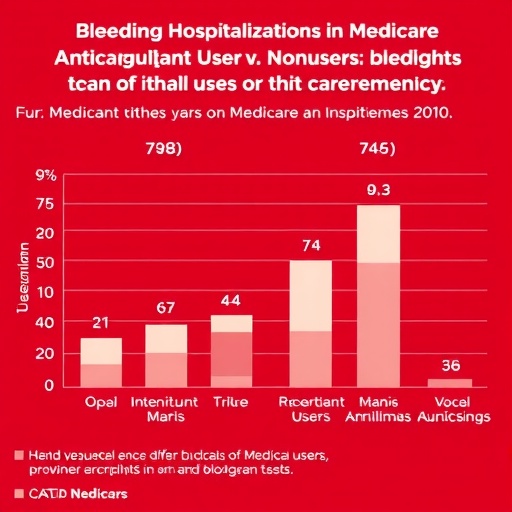PROTECT YOUR DNA WITH QUANTUM TECHNOLOGY
Orgo-Life the new way to the future Advertising by Adpathway
In recent years, the utilization of direct oral anticoagulants (DOACs) has markedly increased among patients requiring anticoagulation therapy. These medications have emerged as preferred alternatives to traditional anticoagulants, primarily due to their convenience and reduced monitoring requirements. However, a significant concern has arisen regarding the safety profile of DOACs, particularly their association with bleeding events that may necessitate hospitalization. A groundbreaking study titled “Bleeding-Related Hospitalizations Among Direct Oral Anticoagulant Users and Nonusers in Medicare Fee-For-Service: Variation in Prevalence, Burden, and Characteristics” provides vital insights into this pressing issue.
This study, recently published in the journal Adv Ther, sets out to explore the prevalence and characteristics of bleeding-related hospitalizations among users of DOACs versus nonusers within the Medicare Fee-For-Service population. The research aims to elucidate the potential risks patients face while undergoing treatment with these newer anticoagulant agents. The findings could potentially inform practitioners’ prescribing practices and enhance patient safety protocols.
Comprehensive analysis performed in this study revealed that individuals utilizing DOACs experience a distinct profile of bleeding-related hospitalizations compared to those not using these medications. The research team meticulously assessed patient demographics, comorbidities, and the specifics surrounding each hospitalization episode. Such thorough investigations contribute to a growing body of literature examining the broader implications of bleeding risks associated with anticoagulation therapy.
Importantly, the study’s findings indicate considerable variability in hospitalization rates between different patient subgroups. For example, it appears that older individuals and those with complex medical conditions may face a higher risk of adverse bleeding events. By identifying those at increased risk, healthcare providers can develop tailored management strategies aimed at mitigating potential complications associated with anticoagulant therapy.
Moreover, the burden of bleeding-related hospitalizations is not merely limited to patients. This phenomenon extends to healthcare systems, leading to increased costs and resource allocation challenges. The healthcare community must recognize that preventing these events is crucial not just for patient well-being but also for optimizing healthcare delivery processes. Those involved in clinical practice need to advocate for effective preventative measures as a priority.
The findings of this research suggest an urgent need for heightened awareness and education within the healthcare community. Understanding patient risk factors for bleeding complications is essential, particularly for healthcare providers prescribing anticoagulant therapies. Comprehensive patient education and shared decision-making can empower patients to understand their treatment options and associated risks better.
As clinicians strive to improve patient outcomes, the data provided in this study can serve as a critical resource. By emphasizing the importance of individualized risk assessment and management, healthcare providers can potentially enhance patient outcomes and minimize hospitalizations related to bleeding events. As the utilization of DOACs becomes more widespread, it is crucial that physicians remain informed about the evolving evidence surrounding these agents.
In addition, it’s important to consider the evolving landscape of anticoagulation therapy. Research like this highlights the importance of balancing the benefits of anticoagulation against the risks associated with bleeding. While the ability to prevent thromboembolic complications is a significant advancement in treating various conditions, the consequences of bleeding complications cannot be understated. Hence, ongoing research and clinical vigilance are necessary to ensure that patients derive the maximum benefit from anticoagulation therapy.
Furthermore, analyzing the patterns of bleeding-related hospitalizations among DOAC users indicates that there are opportunities for improved risk management. For instance, healthcare systems may implement more robust monitoring protocols that specifically target high-risk populations. These measures could include regular follow-ups, augmented patient counseling surrounding potential warning signs of bleeding, and perhaps even enhanced interventions during the initiation of therapy.
The detailed findings elucidated in this study also raise questions regarding the healthcare system’s role in managing anticoagulant therapy. Stakeholders across various levels of healthcare must unify their approach to mitigate the risks associated with anticoagulation therapy. By fostering a collaborative environment where researchers, clinicians, and pharmacists work together, best practices can be established that directly address the safety concerns inherent in anticoagulation therapy.
Patient-centered care is another critical aspect highlighted by the study. The need to prioritize patient safety and understanding should underpin all practices surrounding anticoagulation therapy. By utilizing patient data and leveraging technology, healthcare providers can better engage patients in their treatment processes and equip them with the knowledge they need to make informed choices regarding their health.
As this research highlights, continued advocacy for safe anticoagulation practices is paramount. Future studies must further delineate the risk factors associated with bleeding and explore innovative strategies to reduce hospitalization rates. Implementation of these new strategies could profoundly alter the landscape of anticoagulant therapy, ultimately leading to better patient outcomes.
In conclusion, this study’s findings serve as a crucial reminder of the complexities surrounding anticoagulant therapy. While DOACs represent a significant advancement in the field of medicine, the associated risks, particularly related to bleeding, cannot be overlooked. By engaging in informed discussions about the implications of these findings, the medical community can effectively navigate the challenges posed by anticoagulation therapy to ultimately enhance patient safety and care quality.
In summary, the emerging evidence surrounding bleeding-related hospitalizations among direct oral anticoagulant users warrants careful consideration from healthcare professionals. By utilizing a combination of research, clinical expertise, and patient engagement, the therapeutic journey can be navigated more smoothly, ensuring safer patient outcomes in the realm of anticoagulation therapy.
Subject of Research: Bleeding-related hospitalizations among direct oral anticoagulant users and nonusers.
Article Title: Bleeding-Related Hospitalizations Among Direct Oral Anticoagulant Users and Nonusers in Medicare Fee-For-Service: Variation in Prevalence, Burden, and Characteristics.
Article References:
Bazell, C.M., Alston, M.N., Ganti, L.G. et al. Bleeding-Related Hospitalizations Among Direct Oral Anticoagulant Users and Nonusers in Medicare Fee-For-Service: Variation in Prevalence, Burden, and Characteristics. Adv Ther (2025). https://doi.org/10.1007/s12325-025-03287-4
Image Credits: AI Generated
DOI:
Keywords: bleeding, anticoagulation therapy, direct oral anticoagulants, hospitalizations, patient safety, healthcare delivery.
Tags: anticoagulant prescribing practicesanticoagulation therapy hospitalization risksbleeding hospitalizations Medicare anticoagulant usersbleeding-related hospitalization characteristicscomorbidities in anticoagulant usersdirect oral anticoagulants safety profileDOACs vs traditional anticoagulantshealthcare implications of DOACsMedicare Fee-For-Service studypatient demographics bleeding hospitalizationspatient safety protocols anticoagulationprevalence of bleeding events Medicare


 2 hours ago
6
2 hours ago
6





















 English (US) ·
English (US) ·  French (CA) ·
French (CA) ·